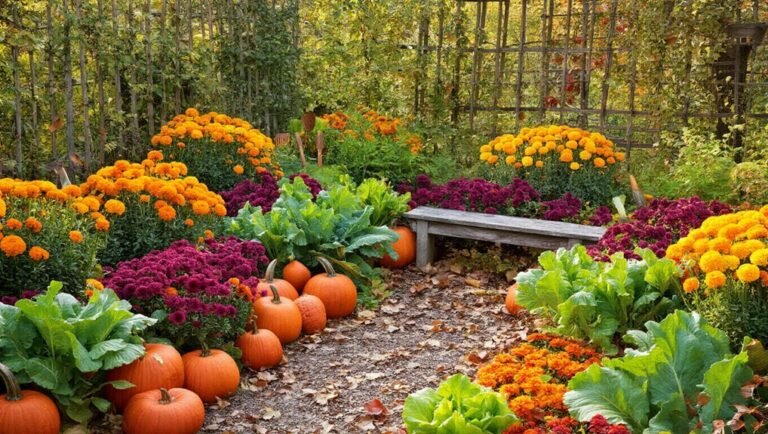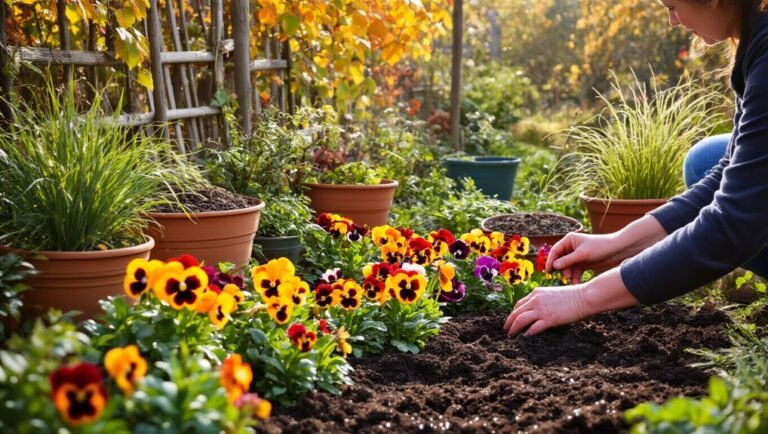To design a winter garden that feeds birds, start by selecting hardy plants like hellebores and evergreens for food and structure. Incorporate bird feeders filled with high-quality seeds near protective shrubs. Set up heated bird baths to provide water, and ensure you clean them regularly. Create shelter with dense plants and birdhouses, and use native species to attract local birds. You’ll find even more tips on maintaining a thriving winter habitat for our feathered friends.
Key Takeaways
- Incorporate hardy perennials and evergreens to provide winter blooms and structure for birds seeking shelter and food.
- Position diverse bird feeders filled with high-quality seeds near protective shrubs for safety and easy access.
- Install heated birdbaths to provide reliable water sources and change water daily to keep it fresh.
- Create dense nesting areas with shrubs and brush piles to offer natural hiding spots and safe shelter.
- Use native plants to attract local wildlife and ensure a continuous food source throughout the winter months.
Selecting the Right Plants for Winter Nourishment
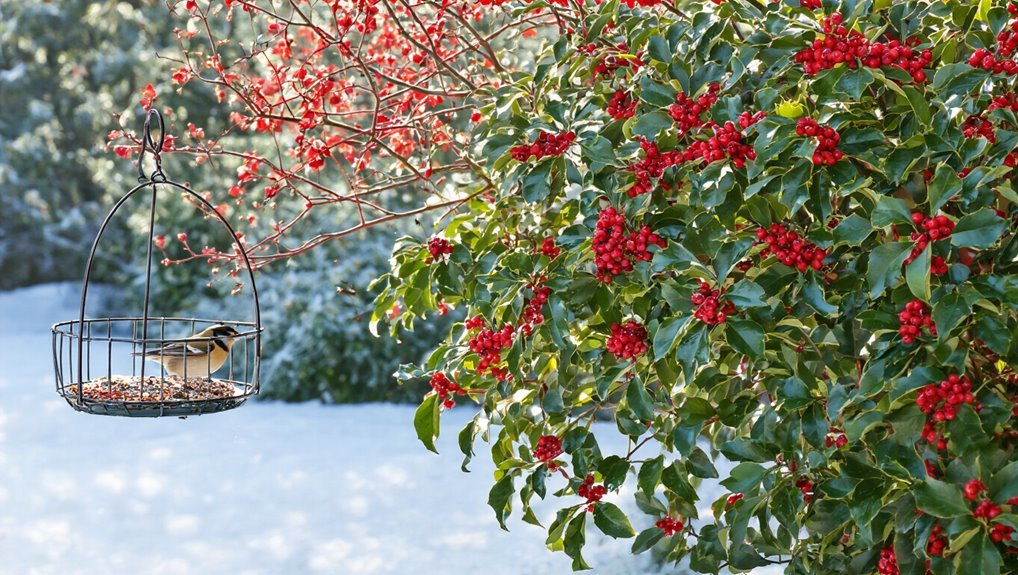
How can you ensure your winter garden stays vibrant and productive? Start by selecting the right plants that thrive in colder temperatures.
Look for hardy perennials, like hellebores and winter jasmine, which bloom even when the ground is frozen. Incorporate evergreens for structure and color throughout the season. Including insect repellent plants like citronella can help protect your garden from pests, even during the colder months.
Consider planting winter vegetables, such as kale and Brussels sprouts, that can withstand frost and provide nourishing greens. You might also add ornamental grasses for texture and movement.
Native plants are a great choice, as they attract local wildlife and require less maintenance.
To add beauty and attract pollinators even in the colder months, you can also plant edible flower seeds that will bloom as soon as temperatures rise.
Incorporating Bird Feeders Into Your Garden Design
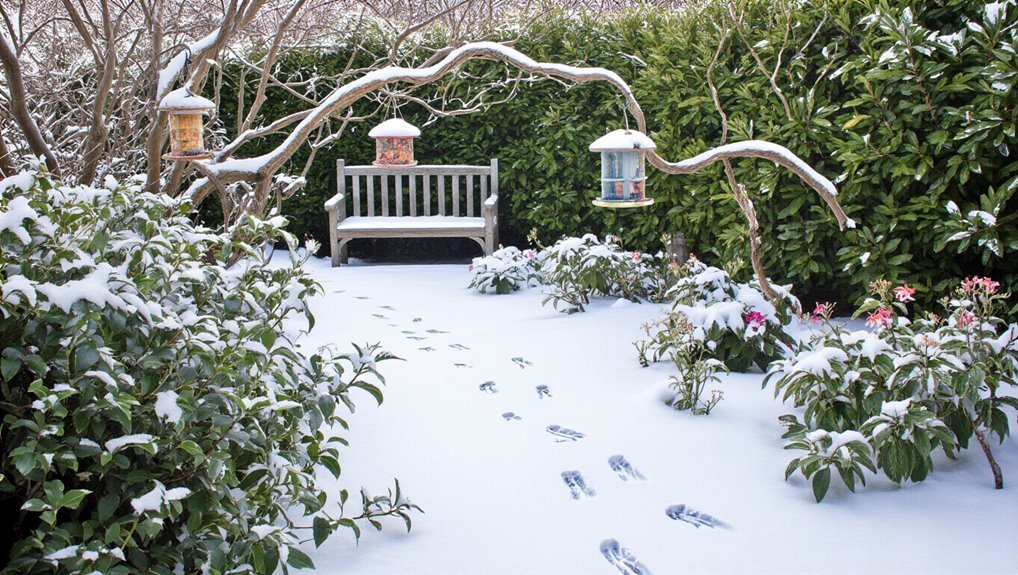
Bird feeders can transform your winter garden into a lively haven for local wildlife. To start, choose feeders that cater to the birds you want to attract. Tube feeders are great for finches, while platform feeders welcome a variety of species.
Place your feeders in visible locations, ideally near protective shrubs or trees, so birds feel safe from predators. For an extra boost to your garden’s ecosystem, consider adding Bee Hotels to provide shelter for pollinators alongside your feathered visitors.
Consider mixing feeder styles to diversify your bird visitors. Use high-quality seeds, like sunflower or millet, to entice them. Regularly clean your feeders to maintain bird health and encourage return visits.
Surround your feeders with winter-friendly plants that provide cover and additional food sources. By thoughtfully incorporating bird feeders, you’ll create a vibrant winter landscape that delights both you and the birds. If you’re searching for the best options, check out these essential bird feeders for your backyard sanctuary.
Providing Water Sources for Birds in Cold Weather
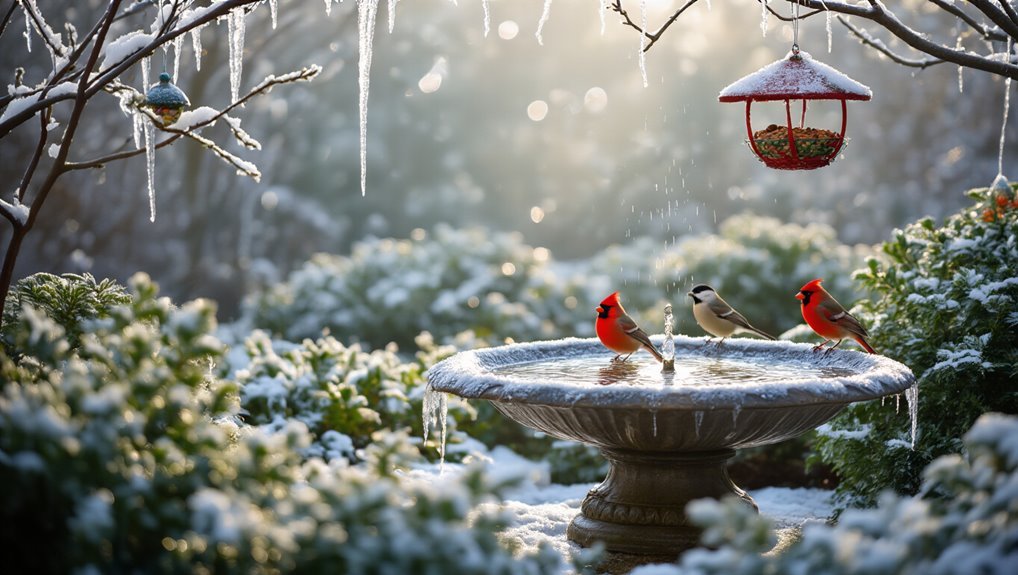
While winter brings a beautiful landscape, it can make finding water challenging for birds. To help them, you can set up reliable water sources in your garden. Heated birdbaths are an excellent option, as they prevent water from freezing. You might also consider shallow dishes filled with fresh water. Remember to change the water daily to keep it clean and inviting. Gardeners can also use watering cans to easily refill birdbaths and dishes, ensuring birds have a fresh supply during cold days. Another useful tool is garden hoses, which allow you to efficiently supply water to multiple birdbaths or containers throughout your yard during winter.
Here’s a quick guide to water sources you can provide:
| Type of Water Source | Description |
|---|---|
| Heated Birdbath | Keeps water from freezing |
| Shallow Dishes | Easy access for small birds |
| Fountains | Provides moving water |
| Ice-Free Containers | Insulated for warmth |
| Water Drippers | Slow release of water |
Creating Shelter and Nesting Areas
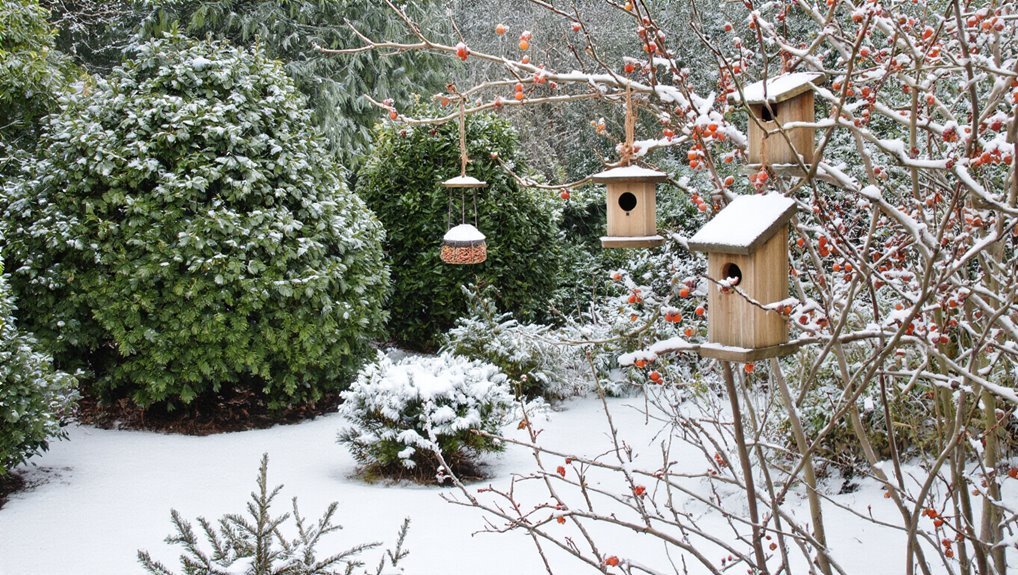
Creating a winter garden that welcomes wildlife means ensuring birds have safe places to shelter and nest.
Start by incorporating dense shrubs and evergreens, which provide excellent cover from harsh winds and predators. Consider adding garden statues to your landscape, as they can serve as decorative focal points while blending naturally with the greenery. You can also add birdhouses, placing them at various heights to accommodate different species. Make sure these houses are well-ventilated and protected from the elements.
Consider leaving some areas of your garden undisturbed; brush piles or tall grass can offer natural hiding spots.
Lastly, avoid using pesticides, as they can harm nesting birds and their food sources.
For an added touch, consider enhancing your space with decorative birdhouses for gardens, which can provide both essential shelter for birds and a charming accent to your garden decor.
Using Native Plants to Attract Local Bird Species
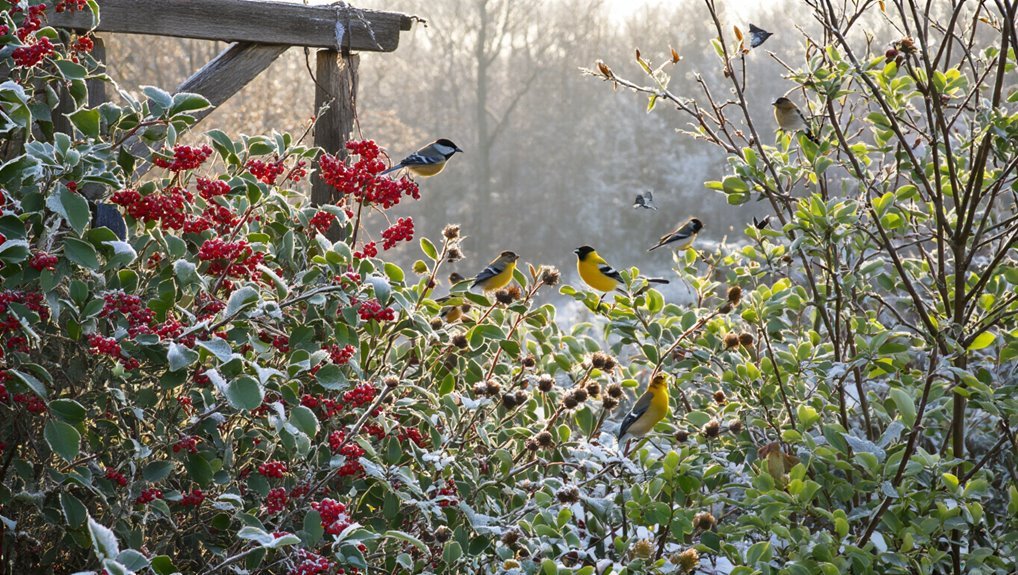
Incorporating native plants into your winter garden not only enhances its beauty but also attracts local bird species.
These plants provide essential food sources, such as seeds and berries, that birds rely on during the colder months. Choose varieties that thrive in your region, ensuring they’re suited to local wildlife. For example, coneflowers, sunflowers, and serviceberries not only look great but also offer nourishment for birds.
Additionally, native plants create a more inviting environment by offering natural shelter and perches. By fostering a diverse plant community, you encourage a variety of bird species to visit your garden.
Embrace the benefits of native flora, and watch your winter garden transform into a vibrant sanctuary for local birds.
Designing a Bird-Friendly Landscape Layout
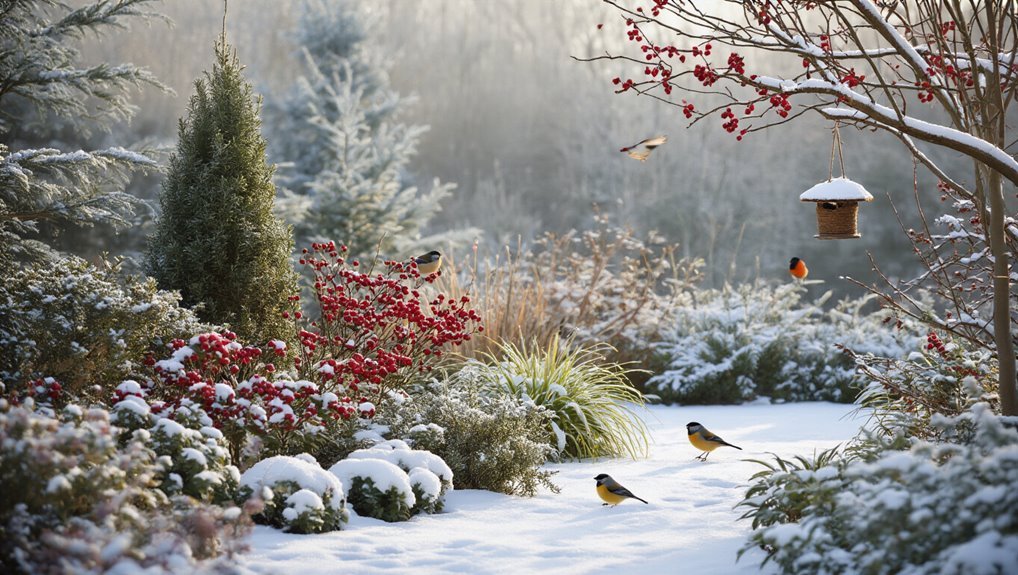
How can you design a bird-friendly landscape layout that invites your feathered friends to visit?
Start by creating diverse layers with trees, shrubs, and ground cover. This variety offers shelter and nesting opportunities.
Position bird feeders near the window, but not too close to avoid window strikes. Incorporate water features like bird baths or small ponds to provide drinking and bathing spots.
Use native plants to ensure a natural food source year-round. Consider adding perches or roosting spots to give birds a safe place to rest.
Avoid using chemicals that could harm them. Finally, maintain a quiet environment; loud noises can deter birds from frequenting your garden.
With these elements, you’ll create a welcoming habitat for your avian visitors.
Maintaining Your Winter Garden for Continued Benefits
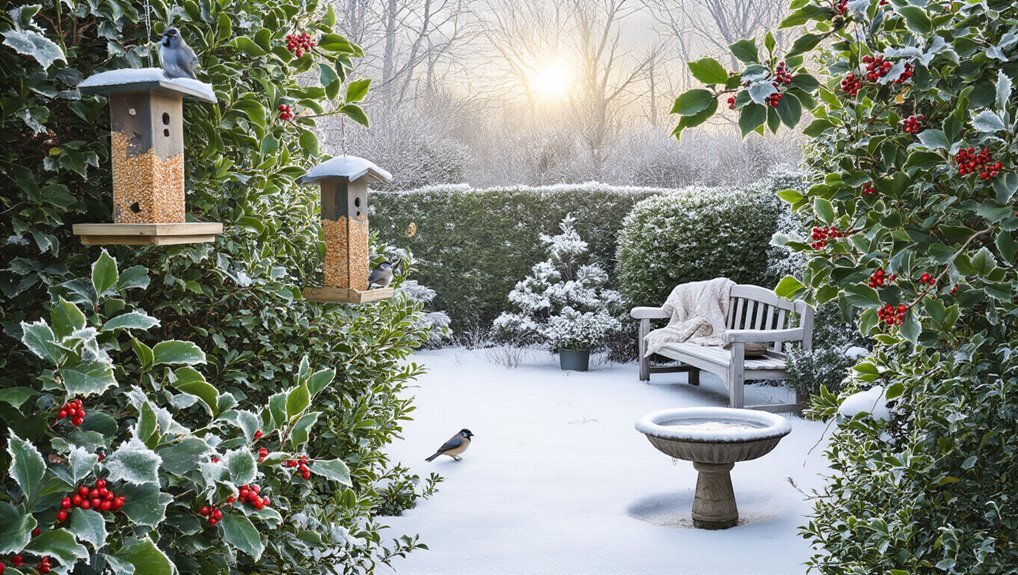
While winter gardens can offer stunning beauty and vital benefits, maintaining them is essential to ensure they thrive throughout the season.
Regular care fosters a welcoming environment for birds and enhances the garden’s aesthetics. Here are a few key maintenance tips:
- Prune dead or damaged branches to promote healthy growth and prevent hazards.
- Clear debris and fallen leaves to minimize pests and disease, keeping your garden tidy.
- Refill bird feeders and baths regularly to attract a variety of feathered friends and provide them with necessary hydration.
- Monitor soil moisture levels to ensure plants remain healthy, particularly during dry spells.
Frequently Asked Questions
What Types of Birds Are Common in Winter Gardens?
In winter gardens, you’ll often spot species like cardinals, finches, sparrows, and chickadees. These birds thrive in cold weather, seeking out seeds and shelter. Keep your garden inviting, and you’ll attract them regularly.
How Can I Keep Bird Feeders Clean During Winter?
To keep bird feeders clean during winter, you should regularly empty and wash them with hot, soapy water. Rinse thoroughly and let them dry completely before refilling to prevent mold and bacteria.
When Is the Best Time to Design a Winter Garden?
When you’re planning your winter garden, aim to start in late summer or early fall. You’ll have time to choose plants, prepare the soil, and ensure everything’s set for the chilly months ahead.
Can I Use Artificial Plants in a Winter Garden?
You can use artificial plants in a winter garden, but they won’t provide food or shelter for wildlife. Instead, consider using real plants that attract birds and enhance the garden’s natural beauty during colder months.
How Do I Deter Unwanted Animals From My Garden?
To deter unwanted animals from your garden, use physical barriers like fencing, plant strong-smelling herbs, and apply repellents. Keeping the area clean and removing food sources will also help discourage them from visiting.
Conclusion
By following these tips, you can transform your winter garden into a bird paradise that’ll make even the most seasoned birdwatchers green with envy! Remember, the right plants, feeders, and water sources are key to attracting our feathered friends during the chilly months. Plus, providing shelter and a thoughtful layout will make your garden a cozy haven. With a little maintenance, your winter garden will be a bustling hub of activity, ensuring birds thrive all season long!

